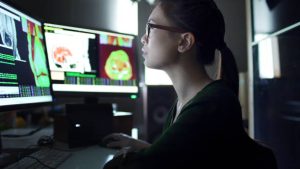Imagine attempting to catch a ghost in the stillness of an old voicemail or decide whether that shadow in hazy surveillance film is a person or perhaps a trick of the light. For the experts analyzing Digital Evidence, daily life is like this. Their toolkit? Science, doubt, and a sloshful of investigative intuition.

On the phone, there is graininess. Static buzz permeates every second as voices fall over one another like stones in a torrent. A salient observation hides in the mess—perhaps. That presents the conundrum. Analyzers come up close with digital waveforms, filter distractions, and enhance weak areas. Sometimes a faint phrase emerges, other times the hum of a refrigerator rules. Ears can only take you so far; software separates frequencies and solves complex jigsaw puzzles of sound where the human senses fall short.
From the video standpoint, things can get crazy. Under flickering lights, figures are seen late-night in a store camera: details smudged like wet paint. That is either a weapon or a wallet. Although they are not magic, footage improvements do help to wring more truth from hazy images. Changing contrast, zooming in, smoothing out unsteady scenes—each change encourages close inspection. Change too much, and someone’s probably going to object: “Did you tamper with this evidence?”
Flip the script now. Sometimes it’s about what’s been cut away, not about what’s currently available. minute leaps in a recording, unusual pauses, or silence incompatible for a given context. Though it’s not always a clear smoking gun, even little irregularities can suggest erased events. Tools for forensic analysis find disruptions, precisely align frames and audio timestamps almost irritatingly.
We should not omit the fresh techniques. Deepfakes and speech generators toss curveballs that could make evidence practically hard to believe at face value. Though the expressions don’t really land, a video appears real. Though they come from cables, not lungs, speech sounds genuine. If you know what to look for, then researchers start prodding for technical problems: awkward jaw motions, smeared pixels, and irregular lighting stand out like a sore thumb.
Ever tried reading a conversation from a noisy party? Imagine now doing this while a jury awaits responses. Reducing noise is a combination of arithmetic and common sense, not only about turning a volume knob. Forensics teams work to eliminate background noise without wiping out the evidence itself by scrubbing. Every action they do—recorded and explained—faces the whole grilling of cross-examination. “How do we know what’s left is the truth?” one wonders even of lifting stationary.
There are many examples in history where this kind of fiddling tipped the balances of justice. Sometimes hissy background noise pulls a confession; other times, it matches indistinct faces with varying camera angles. By use of source comparison and timeline syncing, these methods transform anarchy into clarity.
The most underappreciated instrument is probably skepticism. Suspicions abound if twenty seconds disappears from a police interview. Was something too delicious for the record, or was the battery truly dead? Not merely signals, experts poke and prod at stories. Their goals are not theatrical ones. Clarity is what I mean here.
Remember therefore the next time you are given “clear as day” audio or “irrefutable video proof”: evidence does not vouch for itself. Someone is out there challenging, cleaning, sometimes shaking the basis of what everyone thought they saw or heard. Ultimately, what you get is the most clear signal available—the narrative buried under the din.